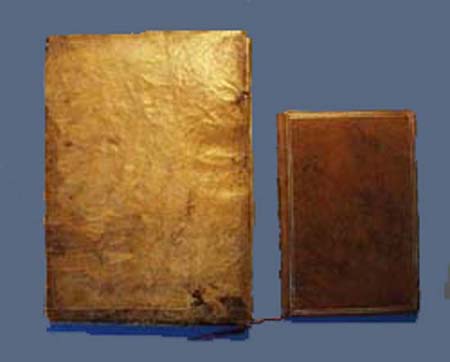The Cosmographia of Petrus Apianus is said to be one of the most popular books on cosmography ever published. It went through no fewer than forty-five editions, was published in four languages, was manufactured in seven cities, by at least eighteen publisher/ printers. This and the following five pages will present the book in greater detail, mentioning its possible sources, enumerating the many versions that evolved over its history, showing the places in which it was manufactured, and identifying its numerous publisher/ printers. A source for more information is given and there is a table of all the known editions of the book.
One of the reasons for the book's enormous popularity was undoubtedly its discussion of the newly discovered lands in the New World. Another was the book's inclusion of ingenious paper devices called volvelles which enabled one to solve practical mathematical problems relating to time-telling, the calendar, and astronomy and astrology. There were three of these volvelles in the first edition, along with numerous woodcut illustrations.
The substance of Cosmographia was not original, however. It relied on classical and medieval sources in the descriptions of the known world, reinforcing the prevalent misinformation about distant lands and people, describing yet again the Sciapodes with their enormous feet which served them as parasols as well as the fanciful barking, dog-headed people said to inhabit a remote part of Asia. The information relating to the New World was derived from two earlier works, the Cosmographiae introductio of Martin Waldseemüller (St. Die, 1507), for whom Apianus had drawn a reduced copy of the former's Map of the World, and the Luculentissima quaeda[m] terrae totius descriptio (The most brilliant description of the whole earth) of Johann Schöner (Nuremberg, 1515). Some scholars think Apianus' Cosmographicus liber is simply an abridgement of Schöner's work.
The success of all of three of these works (and numerous others) was certainly due in part to material drawn from Amerigo Vespucci's Quatuor navigationes (Four voyages) which contained numerous observations on the carnality and sexual excesses of the natives. Waldseemüller was so taken with Vespucci and convinced of his greater importance than Christopher Columbus that he suggested that the new lands be named for the "far-sighted" discoverer. When Waldseemüller realized his error, too many others had already adopted his suggestion, and Amerigo's name remains attached to the new lands to this day.
Apianus' book enjoyed a complicated publishing history that spanned eighty-five years. It was first published in 1524 in the town of Landshut, not at all far from Nuremberg and St. Die. Five years later, Apianus' book was "studiously corrected" by Gemma Frisius, the noted cartographer-mathematician-medical doctor, and the second edition was issued in 1529. In this edition (and most that came later), a fourth volvelle showing the phases of the moon was included, most likely by Gemma.
An abridged version called Cosmographiae introductio, not to be confused with Waldseemüller's work, first appeared in 1531 from Ingolstadt, the town where Apianus lived and held a university professorship in mathematics. This abridgement contains a number of woodcut illustrations but no volvelles.
In 1533, the original, corrected work was enlarged by the addition of two short works by Gemma Frisius: De locorum describendorum ratione (Concerning the method of describing places) and De eorum distantijs inueniendis (Concerning determining their distances). It was with Gemma's additions that the popularity of Cosmographia soared.
The Cosmographicus liber is shown below on the left. The Cosmographiae introductio is on the right.

The book on the left is a copy of the 1545 edition of Cosmographia Petri Apiani containing 52 leaves and manufactured in what is called the quarto format. It measures approximately 21 x 15.5 cm. The book on the right is a 1533 edition of the abbreviated Cosmographiae introductio containing 40 leaves and manufactured in what is called octavo format. It measures 15.5 x 10.5 cm. These format terms are an indication of the size of a book and are based on the number of times a printed sheet of paper has been folded to make the leaves in the book. A quarto book has sheets of paper that have been folded two times at right angles, making a leaf that is one quarter the size of the entire sheet. The smaller octavo book is made by folding the large sheets three times at right angles, making leaves that are one eighth the size of the full sheet. Paper sizes varied and full descriptions require stating the paper size as well. Most copies of both versions of Cosmographia appear to have been printed on a common size of paper known as Royal.
The bindings of books from the 16th century vary considerably as they were bound after purchase to the specifications of their new owners. The binding of the book on the left is made of an animal hide product called vellum, and is very likely the original binding. It is not bound over stiff boards and is therefore called a limp binding. The book on the right has been rebound since it was published. This calf binding with gold tooled lines along the edges of the covers was probably done in the 18th century. The size of a book's pages were often reduced by trimming when they were rebound.
|
|
|